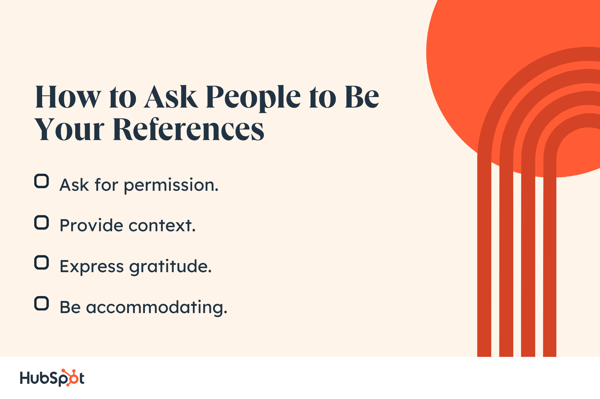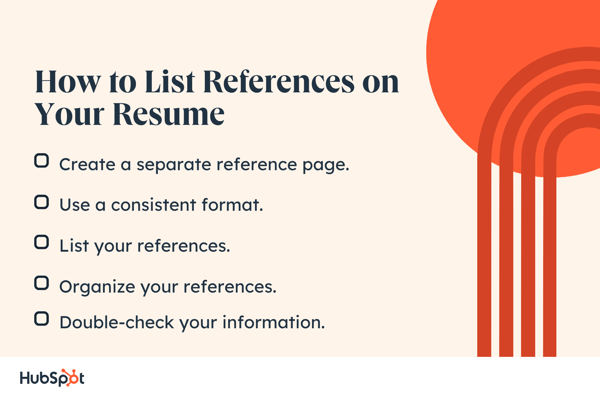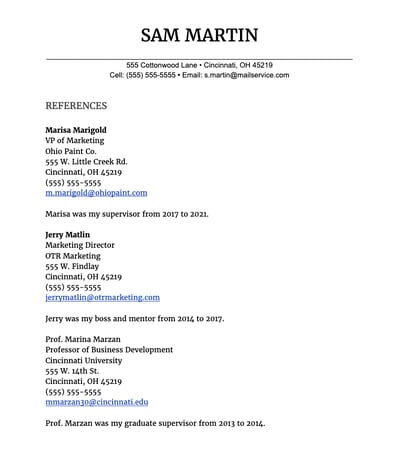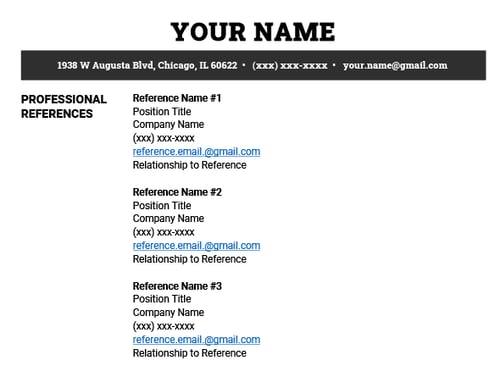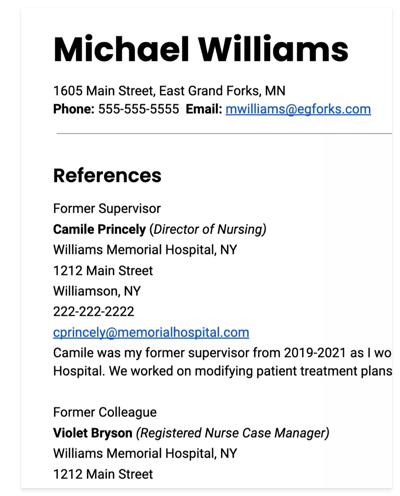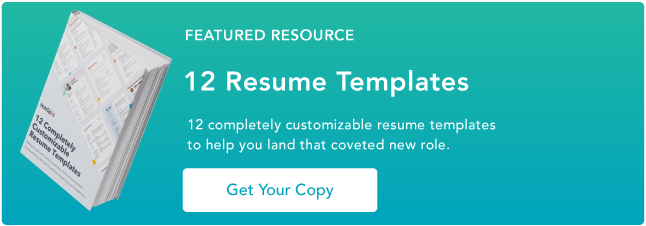“Show me the receipts!” We’ve all heard the phrase, and when it comes to your new job search, those “receipts” are your references on a resume. The difference between snagging that dream job or being left in the dust can sometimes come down to the glowing endorsements of your professional network.
In today’s competitive job market, it’s crucial to stand out, and a cover letter alone may not be enough — but having a well-prepared list of references can be the ace up your sleeve.
In this article, we’ll walk you through the nitty-gritty details of adding references to your resume — from how to notify and list them to formatting them like a pro.
- Should you list references on your resume?
- Should you say “References available upon request”?
- How to Notify Your References
- How to Ask People to Be Your References
- Email Template for Potential References
- How to List References on Your Resume
- How to Format References on Your Resume
- References on Resume vs. Letter of Recommendation
- Resume References Examples
Should you list references on your resume?
The answer, as you might expect, is not a simple yes or no. It depends on several factors, such as the industry, the job you’re applying for, and the stage of your career.
Let’s break down when you should and shouldn’t include references on your resume.
When to Include References on Your Resume
- When specifically requested. If a job posting explicitly asks for references, it’s essential to provide them. In this case, including your references shows that you pay attention to detail and can follow instructions.
- For entry-level positions. If you’re just starting in your career and don’t have much professional experience, including references can help validate your skills and work ethic. In this scenario, consider including references from internships, volunteer work, or even professors.
- When transitioning industries. If you’re switching industries and your work experience isn’t directly related to the job you’re applying for, references from people who can vouch for your transferable skills or your ability to adapt to new environments can be beneficial.
When Not to Include References on Your Resume
- When space is limited. Your resume should ideally be one to two pages. If you’re struggling to fit all your relevant experience and skills, it’s best to save that valuable real estate for showcasing your accomplishments and abilities, rather than including references.
- When not requested. In most cases, employers will ask for references later in the hiring process, while some may list the requirement directly on the job application. Providing them upfront can make your resume look cluttered and may even give the impression that you’re trying too hard.
- When you have limited or weak references. If you’re unable to secure strong references or your references have limited knowledge of your work, it’s better to wait until you’re asked and have time to gather more suitable options.
Should you say “References available upon request”?
You might have seen the phrase “References available upon request” on resumes or even used it yourself, but is it really necessary?
In today’s job market, this statement is generally considered outdated and unnecessary. Here’s why.
Implied Availability
Employers already assume that you have references and that you’ll provide them when asked. Including “References available upon request” on your resume takes up valuable space without adding any new or useful information.
It’s better to use that space to showcase your skills, accomplishments, or experiences that are relevant to the position.
Focusing on Your Strengths
Rather than using the phrase “References available upon request,” concentrate on making your resume as strong as possible.
Highlight your achievements, skills, and experiences that make you an ideal candidate for the job.
If you’re a strong candidate, employers will naturally want to contact your references to confirm your qualifications.
How to Notify Your References
Notifying your references is a crucial step in the job search process. Choosing the right people and asking them to vouch for you can make all the difference.
In this section, we’ll go over how to select and ask potential references to be part of your job search journey.
How to Choose Your References
- Consider your relationship. Pick people who know you well and can speak to your work ethic, skills, and accomplishments. The best references are often former supervisors, colleagues, mentors, professors, or even clients.
- Look for relevance. Choose references who can speak to your abilities in the context of the job you’re applying for, like a direct supervisor. If you’re applying for a managerial role, for instance, a reference who can discuss your leadership skills would be ideal.
- Select a mix of references. Aim for a diverse group of references that can provide different perspectives on your abilities. Include a mix of supervisors, peers, and subordinates, if possible. Your list can be a mix of personal references, character references, and even former colleagues.
- Check their availability. Ensure your chosen references are available and willing to provide a positive recommendation. Make sure they have the time and can be reached easily by potential employers.
How to Ask People to Be Your References
Once you’ve identified the ideal candidates to be your references, it’s time to approach them. Here’s how:
- Ask for permission. Reach out to your potential references, preferably via email or phone call, and politely ask if they’d be willing to be a reference for you. Be sure to provide context about the job you’re applying for and why you think they’d be a great reference.
- Provide context. Share your updated resume and the job description with your potential references so they have a clear understanding of the role and can tailor their recommendations accordingly.
- Express gratitude. Remember to thank them for their time and willingness to help. Your references are doing you a favor, so be sure to show appreciation for their support.
- Be accommodating. Ask them how they would prefer to communicate with the reference check: phone or email. And be sure to tell the recruiter or prospective employer these preferences.
Email Template for Potential References
Subject: [Your Name] – Request for a Professional Reference
Dear [Reference’s Name],
I hope this message finds you well. I am currently in the process of searching for a new position as a [Job Title] and am putting together a list of professional references. Given our positive working relationship at [Company Name] and your firsthand knowledge of my skills and accomplishments, I was hoping you would be willing to serve as a reference for me.
The position I’m applying for requires expertise in [specific skills or experience related to the job]. I believe your perspective on my [mention specific projects, skills, or experiences you worked on together] would be particularly valuable in highlighting my qualifications for this role.
I have attached my updated resume and the job description for your reference. Please let me know if you require any additional information to support your recommendation.
Thank you in advance for your time and consideration. I truly appreciate your help and am grateful for any support you can provide. If you have any questions or concerns, please don’t hesitate to reach out.
Best regards,
[Your Name] [Your Email Address] [Your Phone Number]
How to List References on Your Resume
Although it’s not always necessary to include references on your resume, in cases where it’s required or beneficial, it’s crucial to list them correctly. Part of understanding how to write your resume includes when and where to include references.
Follow these step-by-step instructions to ensure your references are listed in a clear and professional manner.
Step 1: Create a separate reference page.
Instead of listing your references directly on your resume, create a separate document.
This way, you can provide it to the employer upon request or bring it with you to an interview without cluttering your main resume.
This will also save valuable landscape by forgoing a reference section within your main resume.
Step 2: Use a consistent format.
Consistency is key when it comes to formatting your reference page. Use the same header, font, and formatting style as your resume to create a cohesive and professional look.
You can also include your name and contact information at the top of the page, just like on your resume. This is one of the most common mistakes recruiters see on resumes.
Step 3: List your references.
Typically, you should include three to five professional references on your reference page. List them in a clear and organized manner, using the following format:
- Reference Name: Include the full name of your reference.
- Title: Include your reference’s current job title.
- Company: List the company your reference is currently employed by.
- Relationship: Briefly explain your relationship to the reference (e.g., “Former Supervisor” or “Colleague”).
- Contact Information: Provide a phone number and email address where the reference can be reached. Make sure to ask for permission before sharing someone’s contact information.
For example:
John Doe – Senior Project Manager at ABC Corporation – Former Supervisor
Phone: (123) 456-7890 Email: johndoe@email.com
Step 4: Organize your references.
Organize your references in a logical order, such as by relevance to the job you’re applying for or the strength of the relationship.
If you have a particularly strong reference who can speak to your most relevant skills, consider listing them first.
Step 5: Double-check your information.
Before submitting your reference page, double-check all the information for accuracy.
Make sure names are spelled correctly, titles are up-to-date, and contact information is current. You don’t want any errors to reflect poorly on your attention to detail.
How to Format References on Your Resume

Maintain consistency with your resume.
Ensure that your reference page aligns with your resume’s formatting in terms of font type, font size, and layout.
By maintaining a consistent appearance, you’ll create a cohesive and polished look for your application materials.
Use a clear and easy-to-read layout.
Arrange your references in a clean and straightforward manner, making it simple for hiring managers to find the information they need.
Avoid using overly complex or distracting design elements, and opt for a clear layout with appropriate spacing and bullet points.
Organize references by relevance.
List your references in an order that highlights their relevance to the position you’re applying for.
If a reference can speak to your most pertinent skills or experiences, consider listing them first to draw attention to their endorsement.
Include all necessary information.
Ensure that each reference entry includes the individual’s name, job title, company, relationship to you, and contact information (phone number and email address).
This information allows hiring managers to quickly get in touch with your references and understand the context of your professional relationship.
Keep it concise.
While it’s important to provide enough information for hiring managers to understand your relationship with each reference, avoid including excessive detail. Keep your descriptions brief and focused on the most relevant aspects of your professional relationship.
Proofread and double-check.
As with any professional document, it’s crucial to proofread your reference page thoroughly.
Check for any spelling or grammatical errors, as well as inconsistencies in formatting. Additionally, confirm that all details, such as job titles and contact information, are accurate and up-to-date.
References on Resume vs. Letter of Recommendation
While both references and letters of recommendation serve to vouch for your skills and abilities, they are distinct components of the job application process.
Understanding the differences between these two elements and how to use them effectively can give you an edge in your job search. Let’s explore the key differences and when to use each.
References on Resume
References on a resume typically consist of a list of professional contacts who can attest to your skills, work ethic, and overall suitability for a particular job.
These contacts could include former supervisors, colleagues, mentors, professors, or clients. Although it’s not always necessary to include references on your resume itself, it’s a good idea to have a separate, well-formatted reference page ready to provide upon request.
Key points:
- Used for a variety of job types and industries.
- Consists of a list of professional contacts with their titles, company names, relationship to you, and contact information.
- Generally provided upon request or at later stages of the hiring process.
- Aim to include three to five professional references.
Letter of Recommendation
A letter of recommendation is a formal, written document that provides a detailed and personalized endorsement of your skills, accomplishments, and character.
These letters are often written by someone with authority in your field, such as a previous supervisor, professor, or colleague, who can vouch for your abilities and your potential in a new role.
Letters of recommendation are more commonly requested for academic applications, internships, or certain industries and positions.
Key points:
- More commonly used for academic applications, internships, or specific industries and positions.
- Provides a detailed, written endorsement of your skills, accomplishments, and character.
- Typically requested in advance and submitted along with your application materials.
- Aim to have two or three strong letters of recommendation.
When to Use Each
While both references and letters of recommendation can support your job application, they serve different purposes and should be used in different situations.
Here are some guidelines on when to use each:
- References. Have a list of professional references ready to provide when requested by employers during the hiring process. In some cases, such as entry-level positions or when changing industries, you may choose to include references directly on your resume or as a separate reference page.
- Letters of recommendation. Use letters of recommendation when they are specifically requested by an employer or for applications to academic programs, internships, or positions in certain industries. Make sure to ask for these letters well in advance and provide your recommenders with the necessary information to tailor their letters to the position.
Resume References Examples
As you embark on your job search, it’s essential to understand the role references can play in supporting your application.
To help you get a clearer picture of how to present these valuable endorsements effectively, we’ve put together a section dedicated to resume references examples.
Whether you’re new to the job market or an experienced professional, these examples will serve as a valuable guide to help you make the most of your references and ultimately enhance your job prospects.
Unlock the Power of References
Adding job references to your resume can be the final touch that sets you apart from other candidates and helps you land that dream job.
By understanding when and how to include references on your resume, you’ll demonstrate your attention to detail and showcase your strong professional network.
Go to Source
Author: Stephanie Trovato
![→ Download Now: 12 Resume Templates [Free Download]](https://no-cache.hubspot.com/cta/default/53/4ec95757-585e-40cf-9189-6b3885074e98.png)
